How To Change Apps On Iphone 8 Taskbar
How do I adjust my brightness or contrast on my laptop?
Updated: 06/06/2021 by Computer Hope
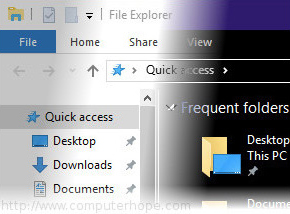
If you are having trouble adjusting the brightness or contrast of your laptop display, keep in mind that every model of laptop (and every operating system) is a little different. Common ways to adjust the brightness and contrast on a laptop computer are provided below.
Tip
Some of the options on this page work for adjusting brightness or contrast on a desktop computer as well.
- Adjusting brightness, using the keyboard.
- Adjusting brightness in the operating system.
- Adjusting contrast.
- Controlling your screen's brightness in Power Options.
- Driver issues.
- Laptop brightness is still not enough or screen is black.
Adjusting brightness using your laptop's keys
PC
On most laptops, you can adjust the brightness of the display using special keys on the keyboard. The keys are usually marked with the brightness symbol (![]() ).
).
Often, the brightness keys are function keys which have a special function if you press them while holding down the Fn key.
The Fn key is usually located to the left of the spacebar. The brightness function keys may be located at the top of your keyboard, or on your arrow keys.


For example, on the Dell XPS laptop keyboard (pictured below), hold the Fn key and press F11 or F12 to adjust the brightness of the screen.
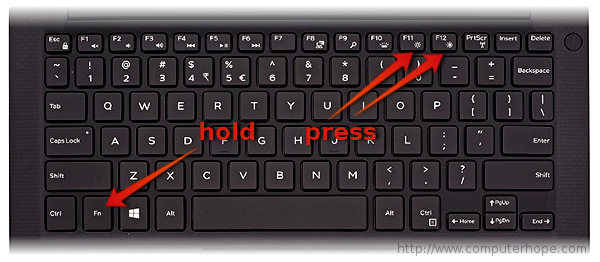
Other laptops have keys dedicated entirely to brightness control. On the HP Chromebook keyboard (pictured below), there is no Fn key — press the brightness keys.
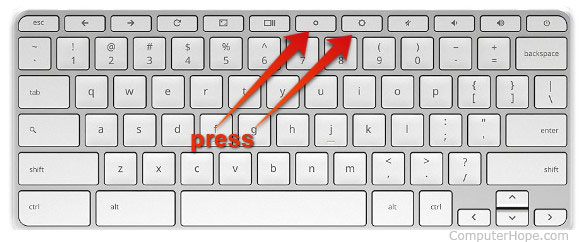
Chromebook
To change the brightness on a Chromebook, you'll need to push one of the two adjustment keys. The small gear lowers the brightness, and the large gear raises it. They are located at the top of the keyboard, as you can see in the red rectangle below.

Adjusting brightness in the operating system
You can also adjust your screen's brightness using software controls on your operating system:
- Windows 10
- Windows 8
- Windows 7
- Apple macOS
- Linux
Windows 10
In Windows 10, there are several ways to adjust the display brightness.
- Using the taskbar's battery icon
- Using the Windows Mobility Center
- Using the Control Panel
Using the taskbar's battery icon
- Click the battery icon on your taskbar.
- In the power status window, click the brightness tile. Each time you click the tile, your brightness will be adjusted by 25%.

Using the Windows Mobility Center
- Open the Power User Tasks Menu by right-clicking the Start menu icon, or by pressing Windows key+X.
- Click Mobility Center (or press B).
- In the Mobility Center, adjust the brightness slider.
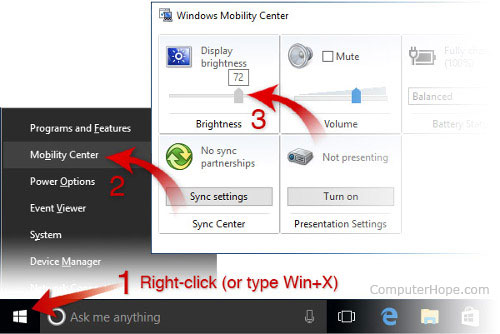
Using the Control Panel
- Open the Control Panel.
- Click Adjust commonly used mobility settings.
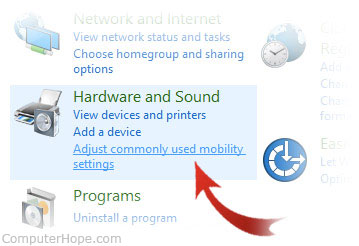
- In the Mobility Center window, adjust the brightness slider.
Adjusting brightness in Windows 8
- Open the Charms bar.
- Select the Settings charm.
- Select the brightness icon.
- Move the slider up and down with your mouse, or by pressing the up and down arrow keys on your keyboard.
Adjusting brightness in Windows 7
- Open the Control Panel.
- Select Hardware and Sound.
- Select Power Options.
- Use your mouse to move the brightness slider at the bottom of the window.
Adjusting brightness in macOS
- From the Apple Menu, choose System Preferences.

- Click Displays.
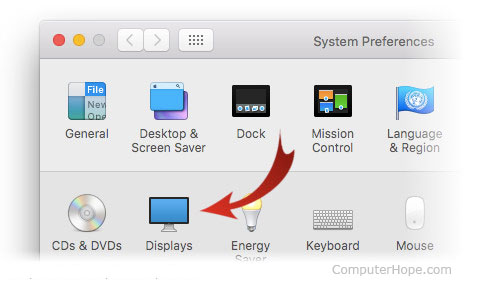
- Use the brightness slider to adjust brightness. If you want your brightness to change automatically based on the ambient light near your computer, check the box marked Automatically adjust brightness.
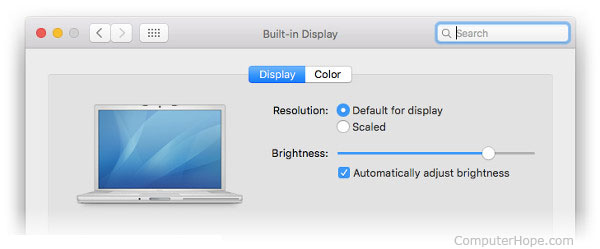
Adjusting brightness in Linux
Many window managers in Linux offer brightness controls in their settings panel. For instance, on Ubuntu systems with the Unity window manager:
- Click the icon at the right of the menu bar.
- Choose System Settings.
- Select Brightness & Lock.
- Adjust the brightness slider.
If your laptop uses Intel or NVidia graphics, you can also use a convenient command-line tool called xbacklight. It can be installed using most package managers. For instance, on Ubuntu or Debian systems:
sudo apt-get update && sudo apt-get install xbacklight
To use xbacklight, specify the option -set percentage , where percentage is a number from 0 to 100. For instance, to set brightness to half:
xbacklight -set 50
To set brightness to full:
xbacklight -set 100
You can also increase or decrease the brightness by a percentage. To increase the brightness by 10%:
xbacklight -inc 10
For a complete list of options, view the manual:
man xbacklight
Adjusting contrast
Most laptops don't have contrast controls at the hardware level, but you can configure your operating system to use a high-contrast display mode.
- Windows 10
- Windows 8
- Windows 7
- macOS
- Linux
Adjusting contrast in Windows 10
- Hold the Shift and Alt keys on the left side of the keyboard, and press the Print Screen key.
- Once asked if you want to turn on High Contrast mode, click Yes.

To switch back to Normal Contrast mode, repeat step 1, and High Contrast mode will be canceled.
If pressing the key combination doesn't bring up the High Contrast prompt, you can enable it in the Ease of Access menu:
- Open the Control Panel.
- Click Ease of Access.
- Select Ease of Access Center.
- Choose Make the computer easier to see.
- Make sure that Turn on or off High Contrast when is checked.
- Click OK.
Adjusting contrast in Windows 8
- Open the Charms bar.
- Click Settings.
- Select Ease of Access.
- Under High Contrast, click the button to turn High Contrast mode on or off.
Adjusting contrast in Windows 7
- Open the Control Panel.
- In the search bar, type window color.
- Click Change window color and metrics.
- Under Basic and high-contrast themes, choose a high-contrast theme.
Adjusting contrast in macOS
- From the Apple Menu, choose System Preferences.
- Click Accessibility.
- Click the Increase Contrast checkbox, and use the Display contrast slider, to adjust your display.
Adjusting contrast in Linux
There are command line tools to adjust the contrast of your screen such as xgamma and xcalib. These can fine-tune any reductions in your screen's default contrast level.
To increase contrast above defaults, most window managers offer a high-contrast theme to make your screen easier to see. In Gnome-based window managers, such as Ubuntu Unity, follow these steps:
- Open a terminal window.
- Run the command gnome-control-center to launch the command center window.
- Click Universal Access.

- Turn on High Contrast.
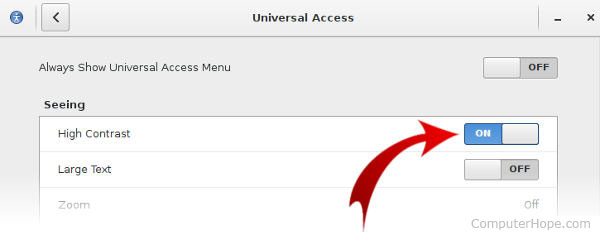
Controlling screen brightness in your Power Options
After adjusting your laptop's brightness, it should retain the new settings automatically. If the brightness settings are not retained after a computer restart, they are probably being overridden by settings in the Power Options menu. If this is the case, you'll need to create a custom power plan, which can be done by accessing the Power Options utility in the Control Panel.
- How to adjust power, standby, and sleep settings.
Driver issues
If the key combination method is not working and you've made the appropriate adjustments in Power Options, it is likely your computer has a video driver problem. Driver issues usually occur after updating the video drivers. Monitor drivers can also cause this problem. To resolve any potential monitor related issues, reinstall the monitor by following the steps below.
- Open the Windows Device Manager
- Click the + or arrow next to Monitors to expand the list.
- Highlight any detected monitors under Monitors and press delete to remove them from the computer.
- Once the monitors are removed from Device Manager, under Action, click Scan for Hardware changes to let Windows re-detect the monitor and install the applicable drivers.
Finally, we also recommend downloading the latest video drivers directly from the video card manufacturer. If this problem was caused because you updated the drivers, install an earlier version of the video drivers to see if that resolves the issue.
- Information and help with computer video drivers.
Laptop brightness is still not enough or screen is black
If, after following the steps above your brightness is still not enough, plug your laptop into the wall. If the laptop is plugged in but still is not bright enough, try the suggestions on the page linked below.
- My laptop computer screen is black.
How To Change Apps On Iphone 8 Taskbar
Source: https://www.computerhope.com/issues/ch000594.htm
Posted by: arnoldtherstion1975.blogspot.com

0 Response to "How To Change Apps On Iphone 8 Taskbar"
Post a Comment